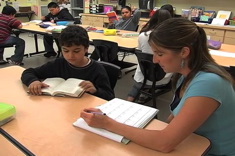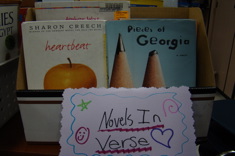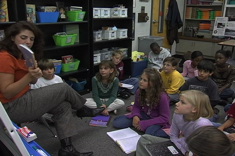Edie stomped into the coach’s office lugging a 15-gallon Rubbermaid storage tub. She dumped the contents out onto a table. Out rolled penguin beanie babies, penguin posters, a DVD of The March of the Penguins, some informational books on penguins, penguin stickers, penguin magnets, penguin notepads, and more! She teared up as she announced, “I love Mr. Popper’s Penguins! I have read it with my fourth graders for the past eight years. I have developed wonderful lessons, a test for every chapter, journal prompts, a Jeopardy game, and even a penguin word wall. Two years ago, I got a permabound class set of Mr. Popper’s Penguins
. Last year, we adopted an Emperor penguin from the World Wildlife Foundation. I’ve collected all of this great stuff! Why can’t I keep teaching it?”
Edie’s school adopted the workshop model for reading and writing instruction. That means no more whole-class novel study. While whole-class novel study has always been the norm in high school classrooms, it began to show up in elementary classrooms in the late 1980s. Teachers were dissatisfied with the offerings in their reading textbooks. The literature was abridged, adapted, and excerpted. Teachers wanted their students to read and enjoy literature in the original version, in its entirety — the way that the author wrote it. The whole-class novel study certainly meets the goal of providing students with the experience of reading and discussing authentic literature.
However, whole-class novel study doesn’t solve all of the problems of using a grade-level reading textbook, and it creates some new problems. A whole-class novel doesn’t meet the instructional needs of all students. It will be too easy for some students and too difficult for others — just like a grade-level reading textbook. One problem created by whole-class novel study is maintaining the interest of all the students throughout the book. Let’s face it. Not all students will like all books. A class will spend 3-6 weeks studying a novel. We can’t afford to have any students disengaged for such an extended period of time. A student might dislike a specific textbook selection and tune out, but textbook selections are completed in 3-5 days. Most students can recover from a few days of tuning out.
Another problem created by whole-class novel study is the “Edie effect.” A teacher may get so caught up in a book that s/he “teaches it to death.” It takes Edie nine weeks to read Mr. Popper’s Penguins and do all of those activities. While I am sure that the fourth graders love all of the penguin activities, they simply are not reading enough. Nine weeks of reading a 139-page book is a little more than three pages a day. At that rate, in an entire school year, they’d end up reading only four novels. So how can Edie be weaned off her beloved novel? The good news is that she doesn’t have to completely give it up.
Read Aloud
Reading aloud Mr. Popper’s Penguins is probably the ideal choice for Edie. Her love for the book will come through loud and clear to her students. They will see it in her face and hear it in her voice. She will be the perfect “reading role model” (Reconsidering Read-Aloud
). Read alouds offer numerous benefits to Edie’s students. Since Edie is doing all the work of reading, her students can completely focus on comprehension. She can briefly pause and talk about interesting words. The meaning of these words is likely to stay with the students longer from the read aloud than from any assignment requiring them to look it up the word in the dictionary. Reading aloud a book that the teacher feels so passionate about will help to enhance the classroom community. If Edie reads a chapter a day to her class, she’ll be done in four weeks instead of nine. If she puts a few copies of the book in her classroom library, I guarantee that they will immediately be checked out. When the struggling readers in the class attempt the book, they will experience more success.
To increase the level of student involvement in the read aloud, Edie might consider using interactive read aloud. She can learn more about it in Interactive Read-Alouds: Linking Standards, Fluency, and Comprehension Grades 4-5.
Shared Reading
Janet Allen has given us permission to engage older students in shared reading. In shared reading, each student has a copy of the book and follows along as the teacher reads aloud. During selected passages, the students read aloud with the teacher. In her book, On the Same Page: Shared Reading Beyond the Primary Grades, she lists the observed benefits of shared reading:
- Students were more motivated to read.
- Attendance improved when students didn’t want to miss what the class was reading.
- Students’ speaking and writing vocabularies increased.
- Students read more on their own.
- The class was more like a community and less like a collection of individuals who happen to be in the same place.
- Students’ writing improved.
- Students began to see themselves as readers.
Literature Circles
Edie can still have the experience of reading Mr. Popper’s Penguins with students. Instead of reading the book with the whole-class, she can invite a small group of students to read the book. In a small group, the book is much more likely to be at the independent or instructional level of all the students. If the book is too challenging for one or two students, it will be easier to support them. In a small group, each student has an increased opportunity to share his/her thoughts, insights, and feelings. The students learn to listen and respond to each other. When reading a book with the whole class, only a few students get the opportunity to talk.
What About All of Those Books?
When a teacher decides to no longer do whole-class novel study, s/he is left with a pile of 15-30 books. Even after retaining a set of books for literature circles, read aloud, mentor texts, and classroom libraries, there will be 8-20 books sitting there collecting dust. Here are some ideas for those books:
- Have a book exchange with other teachers at your grade level. At a grade level meeting, everyone can bring the balance of their whole-class sets and trade. You might even consider a district book exchange.
- With the school district’s permission, sell your leftover books. One way to do this is through a used bookstore online like eBay or Amazon. You can also work with a used book broker like Follett Educational. Directly selling your books will bring in more money, but it’s also a little more work. A used book broker will show up, give you a check, and take the books away — but you’ll get significantly less money. Either way, you can buy new books with the proceeds.
- Donate the books to needy schools. Check out websites such as ILoveSchools.com or the Kipp Schools organization. I am sure that the public schools in New Orleans would love your books. Some schools in affluent districts have sister schools in needy school districts. I don’t think it would be hard to find someone to take ten permabound copies of Mr. Popper’s Penguins
.
Please do something with the books! It really breaks my heart to see books languish in book storage closets.






